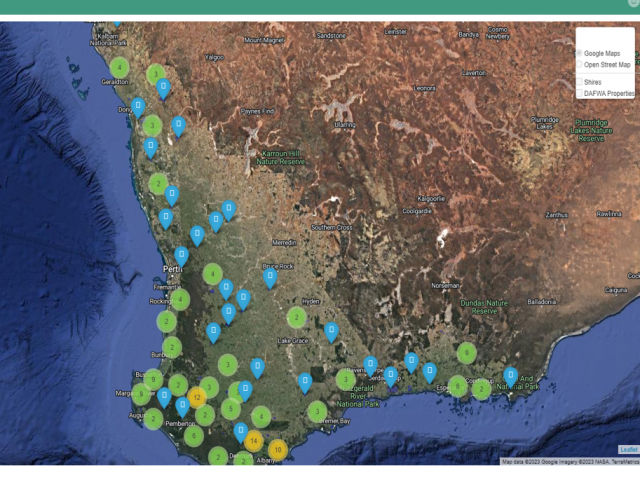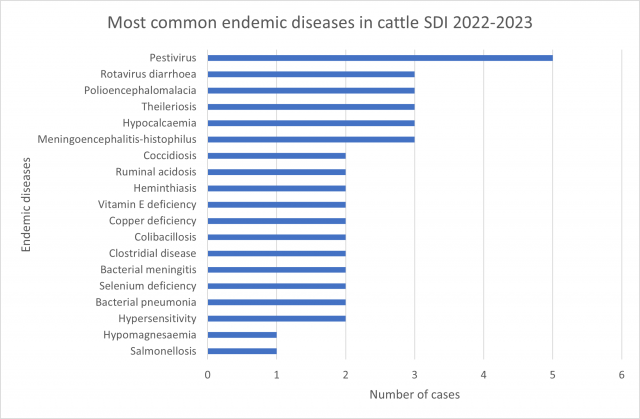Recent livestock disease investigations
Lumpy skin disease excluded in a dairy cow with skin lesions
- A private veterinarian was called to a property within the Perth metropolitan area to examine a 3-year-old Holstein-Friesian cow.
- Staff had noticed this cow to be uncomfortable during milking and found multiple flat red skin lesions on the teats and the underside of the udder.
- This cow was otherwise in good health, no history of mastitis and no discernible milk production drop. No other animals had similar lesions.
- The private veterinarian contacted their local DPIRD field veterinary officer to arrange for laboratory testing, which was subsidised by DPIRD to rule out reportable diseases.
- Samples were collected from the live animal by the private veterinarian and submitted to DPIRD Diagnostic Laboratory Services (DDLS).
- Testing returned a negative result for Lumpy skin disease (LSD). Other diseases excluded were bovine papular stomatitis, pseudocowpox and bovine herpesvirus type 2 and 4.
- Staphylococcus bacterium was identified from the udder lesion, confirming a diagnosis of bacterial dermatitis.
- Common non-reportable diseases that can present as skin lesions in WA cattle include bacterial infections, bovine papular stomatitis, chemical burns, photosensitisation, and plant toxicities.
- It is vital to rule out suspected reportable diseases in susceptible animals. Reportable diseases presenting with skin lesions in cattle include foot-and-mouth disease (FMD) and Lumpy skin disease (LSD). Reportable diseases in sheep and goats would also include peste des petits ruminants (PPR).
- If you see suspicious skin lesions in your livestock, phone a veterinarian. Some exotic diseases, such as lumpy skin disease, can cause similar signs. Testing helps to prove that WA is free from such diseases and further supports the industry.
See DPIRD’s webpage on Lumpy skin disease (LSD) for more information.
If you are concerned about skin lesions in your livestock, contact:
- the EAD Hotline on 1800 675 888
- your private veterinarian
- your local DPIRD field veterinarian.
EAD Hotline alerted DPIRD field veterinarians to deaths in backyard poultry
- A sheep and cropping producer phoned the EAD Hotline to notify DPIRD veterinarians of ongoing deaths in their backyard chicken flock.
- The chickens were dying sporadically over a few weeks with signs of weakness, isolating themselves, pale coloured combs and fluffed up appearance. Overall, there was a mild decrease in egg production in the flock.
- No sheep or other livestock species were affected. Recent environmental changes included baiting for mice and spraying the chicken coop with disinfectant.
- A property visit was organised to view the sick and recently deceased birds. On examination, the DPIRD field veterinarian noted abnormal breathing, discharge from both nostrils, green discolouration of the skin along the neck and purple discolouration on the tips of the comb.
- One carcass was submitted to DDLS laboratory for post-mortem by a senior pathologist and two pathology interns.
- On necropsy, there was extensive haemorrhage which was consistent with the history of possible rodenticide exposure. Although baits were not directly accessible to the chickens, secondary toxicity from consuming poisoned mice was a possible scenario.
- Reportable diseases Avian Influenza (AI) and Newcastle Disease (ND) were excluded by laboratory testing.
- Reportable diseases can have similar signs to common conditions in WA poultry. If you see sudden death in multiple birds, depression, reduced food intake, soft-shelled eggs or a stop in laying, dark combs and wattles, coughing and/or difficulty breathing – phone a veterinarian.
- The earlier the disease is detected, the faster it can be eradicated. If you delay reporting the disease, infectious disease may spread to other birds. It is critical that all poultry owners maintain good biosecurity to prevent diseases entering their flocks and report any signs of disease as soon as possible.
In late spring/summer be on the lookout for:
Pulpy kidney disease in lambs
- Pulpy kidney, or enterotoxaemia, is a disease of sheep, cattle and goats.
- It is caused by the bacterium Clostridium perfringens type D which is a normal bacterium of the animal’s intestines.
- A rapid change to a low-fibre, high-carbohydrate diet exacerbates multiplication of the bacterium and production of toxins.
- Sudden death occurs in rapidly growing unweaned or weaned lambs on lush pasture, cereal crops, spilt grain or fed grain.
- In older sheep, pulpy kidney is likely to occur after they are moved onto good feed.
- Lambs are generally in good condition, die quickly with convulsions or are found dead often on their sides with limbs extended and heads thrown back.
- Animals are usually unvaccinated or inadequately vaccinated.
Read more on pulpy kidney (enterotoxaemia) in sheep.
Barber's pole worm in sheep
- Is usually seen in late spring/early summer in coastal areas of agricultural regions of WA.
- Weaners with inadequate immunity are commonly affected at this time of the year.
- Signs include sudden death, anaemia, weakness and bottle-jaw.
- Weaned lambs have reduced immunity to worms and depend on an effective drenching program. Weaned lambs that have not received their weaning drench (ideally 14 weeks after the start of lambing and no later than 18 weeks) and then their first summer drench (about 4 weeks after pasture senescence or no later than early December) are at risk of having significant worm burdens.
Read more on Barber’s pole worm, and contact your veterinarian for more information.
Selenium deficiency in lambs and calves
- It occurs mostly in young animals as they have an increased demand for the essential trace element during growth and have not accumulated the reserves of adult animals.
- Animals are typically grazing lush, rapidly growing pasture or legume-dominant pasture in the higher rainfall areas of the southwest coastal regions.
- Paddocks heavily fertilised with superphosphate applications may also predispose animals to deficiency.
- Signs of selenium deficiency include poor growth, stiff gait, arched back, apparent lameness, reluctance to move and sudden death. Selenium deficiency can also cause low fertility in breeding animals.
Read more about selenium deficiency in sheep and cattle.
Significant disease investigation program summary for the 2022-2023 financial year
A total of 170 significant disease investigations were completed by private veterinarians in the last financial year from July 2022 to June 2023.
The Significant Disease Investigation (SDI) program remains central to providing the data required for early disease detection and to underpin health certification for export market access. Nearly all the cases confirmed an endemic diagnosis that the veterinarian could assist the producer to manage, highlighting the benefit of the program to producers in managing disease and production on-farm. The investigations also supported evidence of absence of trade sensitive diseases in 54 of the 171 cases subsidied by this program.
| Species | SDI submissions |
|---|---|
| Ovine | 102 |
| Bovine | 66 |
| Caprine | 3
|
| Porcine | 0 |
| Camelid | 0 |
The program demonstrates geographic reach* and there has been a year-on-year increase in the number of veterinarians and practices engaging with the program.
*northern Australia is covered by a separate program

Most common EAD exclusions performed during the 2022-23 financial year
Most common endemic diseases diagnosed through SDI submissions during the 2022-23 financial year
Livestock disease investigations protect our markets
Australia’s ability to sell livestock and livestock products depends on evidence from our surveillance systems to prove we are free of livestock diseases that are reportable or affect trade. The WA Livestock Disease Outlook – for producers summarises recent significant disease investigations by Department of Primary Industries and Regional Development (DPIRD) veterinarians and private veterinarians that contribute to that surveillance evidence. Data from these investigations provides evidence that WA is free from these diseases and supports our continuing access to markets.
Find out more about WA's animal health surveillance programs.
Feedback
We welcome feedback. To provide comments or to subscribe to the monthly newsletter, email waldo@dpird.wa.gov.au. To see previous issues of the WALDO – for producers, please visit our archive page.




